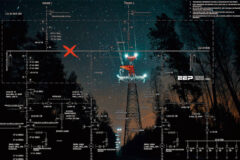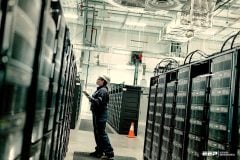Stubborn factory owners
This technical article I dedicate to stubborn factory owners who still don’t believe and don’t want to spend the money on optimizing the factory costs.

Not all of them are like that, but the most of them ‘not-much-electrically-educated’ are. So, let’s start with explaining.
The fact is that power capacitors provide many benefits, and among them //
- Reduced electric utility bills
- Increased system capacity
- Improved voltage
- Reduced losses
Reduced utility bills is not an imagination
Your electric utility provides working (kW) and reactive power (kVAR) to your plant in the form of apparent power (kVA).
While reactive power (kVAR) doesn’t register on kW demand or kW hour meters, the utility’s transmission and distribution system must be large enough to provide the total power. Utilities have various ways of passing the expense of larger generators, transformers, cables, switches, and the like, along to you.
kVA billing
In case you didn’t know, the utility measures and bills every ampere of current, including reactive current. Let’s observe the optimizing costs in the following two cases, but before this, please jump and read what’s common for beer mug and power factor? Your eyes will open :)
Case 1 //
Assume an uncorrected 460 kVA demand, 480V, three-phase at 0.87 power factor (normally good).
Billing:
$4.75/kVA demand
Correct to 0.97 power factor
Solution:
kVA × power factor = kW
460 × 0.87 = 400 kW actual demand
kW = kVA PF
400 = 412 corrected billing demand 0.97
From Table 1, kW multipliers, to raise the power factor from 0.87 to 0.97 requires capacitor:
Multiplier of 0.316 x kW
0.316 x 400 = 126 kVAR (use 140 kVAR)
Uncorrected original billing:
460 kVA × $4.75 = $2185 / month – $1957
= $ 228 / month savings × 12
= $2736 annual savings
Corrected new billing:
412 kVA × $4.75 = $1957/month
140 kVAR, 480V capacitor cost: $1600 (installation extra).
Case 2 //
Assume the same conditions except that:
- 400 kW at 87% = 460 kVA
- 400 kW at 97% = 412 kVA corrected billing
kVA demand charge:
$1.91 / kVA / month (112,400 kWh / month energy consumed)
Energy charge:
$0.0286 / kWh (first 200 kWh / kVA of demand)
$0.0243 / kWh (next 300 kWh / kVA of demand)
$0.021 / kWh (all over 500 kWh / kVA of demand)
Uncorrected:
460 kVA × $1.91 = $878.60 – $786.92
$ 91.68 savings in demand charge
Corrected:
412 kVA × $1.91 = $786.92
Uncorrected energy:
kWh = 112,400
460 × 200 = 92,000 kWh
at 0.0286 = $2631.20
460 × 300 = 138,000
but balance only = 20,400
at $0.0243 = $495.72
$2631.20 + $ 495.72
$3126.92 uncorrected energy charge
Corrected energy:
kWh = 112,400
460 × 200 = 82,400 kWh
at 0.0286 = $2356.64
460 × 300 = 123,600
but balance only = 30,000
at $0.0243 = $729.00
$2356.64 + $ 729.00
$3085.64 corrected energy charge
$3126.92 – $3085.64
$ 41.28 savings in energy charge due to rate charge
(9600 kWh in first step reduced by $0.0043)
This is not a reduction in energy consumed, but in billing only.
$ 41.28 energy – $ 91.68 demand
$ 132.96 monthly total savings × 12 = $1595.52
Table 1 //
Multipliers to Determine Capacitor Kilovars Required for Power Factor Correction


Installing a capacitor bank (VIDEO)
Reference // Power factor correction: a guide for the plant engineer – ABB











Hello,
I am amazed with your work. I am an electrical engineer, but I don’t know how you were able to install power factor correction at your workplace and at home.
I humbly asking, do you mind lecturing me on how I can do same in my house. I am getting lots of bills.
Thanks for your understanding.
Cheers
Charles
I am a retired licensed professional engineer. At 78 I am ashamed to admit that I can’t remember the calculations of power factor. I knew when the took aaway our watt-hour meters and gave us new magic smart meters that only measure volt-ampere hours instead of watt hours, my air conditioner costs would be higher. They give you no choice, they take away the old meter and install the new one. Assuming a 1kw load at .8 power factor how much capacitance should I put across the AC motor to acheive unity power factor.
I have installed a bank of capacitors on my main electrical panels at my store with 4 ac units and 15 refrigeration compressors and have seen a reduction in my bill of almost $1800 a month. I also installed some at my house and I have seen a reduction of over $100 a month. A lot of people will never understand the concept.
Your comments are very encouraging to a learner like me. I am really interested to learn from you how capacitors can be used at home to reduce power cost. Usually I incur around 150KW hours a month. KWH x price per unit = Electricity cost. I hope I am correct. Could you please be kind enough to educate me how I can use capacitors to reduce my electricity cost, what size of capacitors should I use, should I install a capacitor bank coupled to my main switch board etc. I will treat this valuable information a great help for me. Thank you in advance for your kind help. I am from Sri Lanka.
Have you ever considered installing capacitor banks at individual loads.
If yes, on what basis???
460 × 200 = 82,400 kWh
at 0.0286 = $2356.64
how is it 460 X 200 = 82,400??
460x200x0.9=82800
Hi, i want to ask in the first case when you say 400=412 , the 412 come from the 460 KVA * 0,97 PF ?Thanks in advance .
After the installation the customer has to notify (utility company) the power factor correction to test, verification and the proper certification. Finally the utility make a change in the load contract and in the next bill the customer has a cost benefit.
PFC companies obtain KVA, kwh, utility bill etc for about 6 months before installation ,then after installation they take readings and show client that their predictions are correct.
Yes power factor corecting capacitors fitted at the main supply of an installation will absoulety reduce the electricity bills.
I would love to talk about the science behind it but I know that the layman would not get it.
All you need to understand is that as long as you have mostly inductive loads (not resistive loads) then you can save money on your bills.
What if arc welders make up 50 % of peak demand and this is asynchronous pulsed current?
How does resonant frequency; typically chane with optimum Cpf table
How is EMI affected in both conducted and radiated? Worse or better?
Line impedance vs f will be reduced significantly with passive PFC to raise impulse currents from avalanche effects from arc welds.